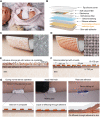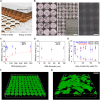Thermally switchable, crystallizable oil and silicone composite adhesives for skin-interfaced wearable devices
- PMID: 35687686
- PMCID: PMC9187235
- DOI: 10.1126/sciadv.abo0537
Thermally switchable, crystallizable oil and silicone composite adhesives for skin-interfaced wearable devices
Abstract
Continuous health monitoring is essential for clinical care, especially for patients in neonatal and pediatric intensive care units. Monitoring currently requires wired biosensors affixed to the skin with strong adhesives that can cause irritation and iatrogenic injuries during removal. Emerging wireless alternatives are attractive, but requirements for skin adhesives remain. Here, we present a materials strategy enabling wirelessly triggered reductions in adhesive strength to eliminate the possibility for injury during removal. The materials involve silicone composites loaded with crystallizable oils with melting temperatures close to, but above, surface body temperature. This solid/liquid phase transition occurs upon heating, reducing the adhesion at the skin interface by more than 75%. Experimental and computational studies reveal insights into effects of oil mixed randomly and patterned deterministically into the composite. Demonstrations in skin-integrated sensors that include wirelessly controlled heating and adhesion reduction illustrate the broad utility of these ideas in clinical-grade health monitoring.
Figures






Similar articles
-
Skin-Integrated Devices with Soft, Holey Architectures for Wireless Physiological Monitoring, With Applications in the Neonatal Intensive Care Unit.Adv Mater. 2021 Nov;33(44):e2103974. doi: 10.1002/adma.202103974. Epub 2021 Sep 12. Adv Mater. 2021. PMID: 34510572
-
Skin-interfaced biosensors for advanced wireless physiological monitoring in neonatal and pediatric intensive-care units.Nat Med. 2020 Mar;26(3):418-429. doi: 10.1038/s41591-020-0792-9. Epub 2020 Mar 11. Nat Med. 2020. PMID: 32161411 Free PMC article.
-
Bitter Flavored, Soft Composites for Wearables Designed to Reduce Risks of Choking in Infants.Adv Mater. 2021 Oct;33(39):e2103857. doi: 10.1002/adma.202103857. Epub 2021 Aug 8. Adv Mater. 2021. PMID: 34369002
-
Wireless Technologies in Flexible and Wearable Sensing: From Materials Design, System Integration to Applications.Adv Mater. 2024 Jul;36(27):e2400333. doi: 10.1002/adma.202400333. Epub 2024 Apr 30. Adv Mater. 2024. PMID: 38652082 Review.
-
Recent advances in noninvasive flexible and wearable wireless biosensors.Biosens Bioelectron. 2019 Sep 15;141:111422. doi: 10.1016/j.bios.2019.111422. Epub 2019 Jun 18. Biosens Bioelectron. 2019. PMID: 31229794 Review.
Cited by
-
Technology Roadmap for Flexible Sensors.ACS Nano. 2023 Mar 28;17(6):5211-5295. doi: 10.1021/acsnano.2c12606. Epub 2023 Mar 9. ACS Nano. 2023. PMID: 36892156 Free PMC article. Review.
-
Self-Powered Smart Textile Based on Dynamic Schottky Diode for Human-Machine Interactions.Adv Sci (Weinh). 2023 Apr;10(11):e2207298. doi: 10.1002/advs.202207298. Epub 2023 Feb 13. Adv Sci (Weinh). 2023. PMID: 36782105 Free PMC article.
-
Multiscale crack trapping for programmable adhesives.Sci Adv. 2024 Sep 13;10(37):eadq3438. doi: 10.1126/sciadv.adq3438. Epub 2024 Sep 11. Sci Adv. 2024. PMID: 39259793 Free PMC article.
-
Flexible electronics for cardiovascular monitoring on complex physiological skins.iScience. 2024 Aug 12;27(9):110707. doi: 10.1016/j.isci.2024.110707. eCollection 2024 Sep 20. iScience. 2024. PMID: 39262772 Free PMC article. Review.
-
Motion-Adaptive Tessellated Skin Patches With Switchable Adhesion for Wearable Electronics.Adv Mater. 2025 Jan;37(4):e2412271. doi: 10.1002/adma.202412271. Epub 2024 Oct 20. Adv Mater. 2025. PMID: 39428834 Free PMC article.
References
-
- Lund C., Medical adhesives in the NICU. Newborn Infant Nurs Rev 14, 160–165 (2014).
-
- de Oliveira Marcatto J., Santos A. S., Oliveira A. J. F., Costa A. C. L., Regne G. R. S., da Trindade R. E., Couto D. L., de Souza Noronha K. V. M., Andrade M. V., Medical adhesive-related skin injuries in the neonatology department of a teaching hospital. Nurs. Crit. Care , 10.1111/nicc.12621 (2021). - PubMed
-
- Konya C., Sanada H., Sugama J., Okuwa M., Kamatani Y., Nakagami G., Sakaki K., Skin injuries caused by medical adhesive tape in older people and associated factors. J. Clin. Nurs. 19, 1236–1242 (2010). - PubMed
-
- Chung H. U., Kim B. H., Lee J. Y., Lee J., Xie Z., Ibler E. M., Lee K., Banks A., Jeong J. Y., Kim J., Ogle C., Grande D., Yu Y., Jang H., Assem P., Ryu D., Kwak J. W., Namkoong M., Park J. B., Lee Y., Kim D. H., Ryu A., Jeong J., You K., Ji B., Liu Z., Huo Q., Feng X., Deng Y., Xu Y., Jang K.-I., Kim J., Zhang Y., Ghaffari R., Rand C. M., Schau M., Hamvas A., Weese-Mayer D. E., Huang Y., Lee S. M., Lee C. H., Shanbhag N. R., Paller A. S., Xu S., Rogers J. A., Binodal, wireless epidermal electronic systems with in-sensor analytics for neonatal intensive care. Science 363, eaau0780 (2019). - PMC - PubMed

